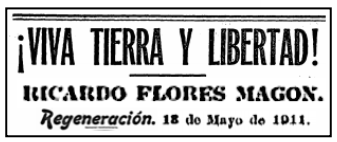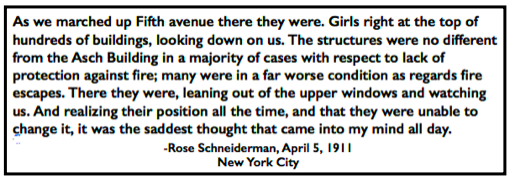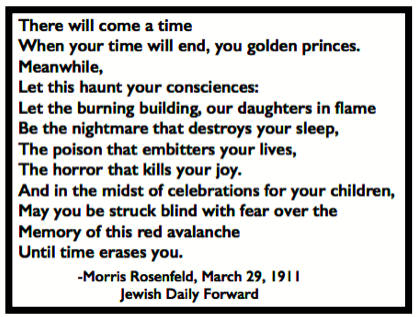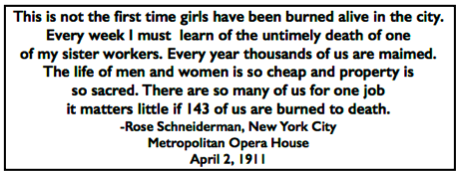 ———-
———-
Hellraisers Journal – Saturday May 13, 1911
The Red Flag Now Flies Gallantly Over Tijuana!
From Regeneración of May 13, 1911:
—–
[Notice of the Capture of Tijuana from C. Pryce]
 ———-
———-
Hellraisers Journal – Saturday May 13, 1911
The Red Flag Now Flies Gallantly Over Tijuana!
From Regeneración of May 13, 1911:
—–
[Notice of the Capture of Tijuana from C. Pryce]
 —————
—————
Hellraisers Journal – Saturday May 6, 1911
“The Triangle Fire” by Martha Bensley Bruere, Part II
From Life and Labor of May 1911:
The Triangle Fire
By Martha Bensley Bruere
Well, the fire is over, the girls are dead, and as I write, the procession in honor of the unidentified dead is moving by under my windows. Now what is going to be done about it?
Harris and Blanck, the Triangle Company, have offered to pay one week’s wages to the families of the dead girls-as though it were summer and they are giving them a vacation! Three days after the fire they inserted in the trade papers this notice:
NOTICE, THE TRIANGLE WAIST CO. beg to notify
their customers that they are in good working order.
HEADQUARTERS now at 9-11 University Place.The day after they were installed in their new quarters, the Building Department of New York City discovered that 9-11 University Place was not even fireproof, and that the firm had already blocked the exit to the one fire escape by two rows of sewing machines, 75 in a row, and that at the same time repairs were begun on the old quarters in the burned building under a permit winch called for no improvements or alterations of any conditions existing before the fire. It called for repairs only, which means, it was generally conceded, that the place would be re-opened in the same condition it was in before the fire.
That is what the employers have done.
 —————
—————
Hellraisers Journal – Friday May 5, 1911
“The Triangle Fire” by Martha Bensley Bruere, Part I
From Life and Labor of May 1911:
The Triangle Fire
By Martha Bensley Bruere
The Triangle Shirt Waist Shop in New York City, which was the scene of the great fire on March 25th, when 143 [146] workers were killed, was also the starting point of the strike of the forty-thousand shirt waist workers in 1909.
The girls struck because they wished to stand together for decent shop conditions, wages on which they could live and reasonable hours, and neither Mr. Harris nor Mr. Blanck, both of whom were members of the Manufacturers’ Association, would allow their workers to unite in any way at all.
It happened that I did picket duty morning and night before that shop and saw the striking girls go up to the strike-breakers and ask timidly:
“Don’t you know there’s a strike by the Triangle?”
It was before this Triangle Shop that the girls were clubbed by the police and by the hired thugs who assisted them; and it was in the streets around it that a large number of arrests were made. The girl pickets were dragged to court, but every one from this shop was discharged. The police and the government of the city had banded themselves together to protect the property of Harris and Blanck, the Triangle Shirt Waist firm.
The six hundred girls who worked at the Triangle Shop were beaten in the strike. They had to go back without the recognition of the union and with practically no change in conditions. On the 25th of March it was these same policemen who bad clubbed them and beaten them back into submission, who kept the thousands in Washington Square from tramping upon their dead bodies, sent for the ambulances to carry them away, and lifted them one by one into the receiving coffins which the Board of Charities sent down in wagon loads.
I was coming down Fifth Avenue on that Saturday afternoon when a great swirling, billowing cloud of smoke swept like a giant streamer out of Washington Square and down upon the beautiful homes in lower Fifth Avenue. Just as I was turning into the Square two young girls whom I knew to be working in the vicinity came rushing toward me, tears were running from their eyes and they were white and shaking as they caught me by the arm.
“Oh,” shrieked one of them, “they are jumping.”
 —————
—————
Hellraisers Journal – Wednesday May 3, 1911
Louis Duchez on Murder of Shirtwaist Makers in New York City, Part I
From the International Socialist Review of May 1911:
THE MURDER OF THE SHIRT WAIST MAKERS
IN NEW YORK CITYBY LOUIS DUCHEZ
Photographs by American Press Ass’n.
[Part I of II.]
TRUTH is, indeed, stranger than fiction.
As I write this story of the bold, brutal and cold-blooded murder of one hundred and twenty-five [129] girls, averaging nineteen years of age, and twenty [17] men, here in New York, I wonder if what I have seen and heard and felt is real.
It was Saturday evening, March 25. Only five minutes more and the slaves at the sewing machines would be hurrying to their “homes,” carrying their starvation wages for the week. More than 500 of them were employed by the Triangle Waist Company, the non-union concern which led the fight on the shirt waist girls more than a year ago. The slave pen was located on the eighth, ninth and tenth floors of a “fire proof” building in the very heart of the congested section of the city.
In some corner unknown on the eighth floor highly inflammable materials caught fire. Before anyone had time to look around big tongues of flame were licking up everything in the room.
A general rush was made for the elevators and stairways. The elevators did their best, but during the few minutes in which the tragedy occurred only fifty girls were lowered.
The stairways were the principal ways of escape—and the doors leading to these stairways were locked. For it was the custom of this firm, as it is the custom in other shirtwaist factories in New York, to lock the doors after work begins in the morning and to keep them locked all day, so that the employes may be searched before going home for pieces of goods, thread or buttons, and so that they may be prevented from going out and “stealing time” during the day.
Everywhere throughout the three floors silk and cotton goods hung from racks or were piled up on tables, and the little blaze which started in the unknown corner was like a spark in a powder magazine. In ten minutes the three floors were all afire. Huge clouds of flame belched from nearly every window.
Finding the doors locked to the stairways, the girls rushed to the windows. With their hair and clothes afire, they leaped from the eighth, ninth and tenth story windows. Some were seen climbing upon the sills and deliberately plunging to the pavement. Others, it is said, were pushed out by the pressure behind. In one instance two girls came down from the ninth story in each other‘s arms. Others were seen embracing and kissing each other before making the fatal leap.
 —————
—————
Hellraisers Journal – May Day 1911
“The Cooperative Commonwealth” by Walter Crane
From The Coming Nation of April 22, 1911: